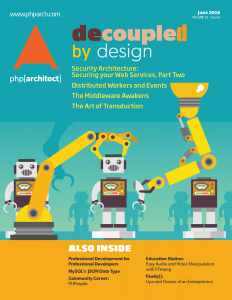Security Architecture: Securing your Web Services, Part Two
Any web service security architecture should be a combination of standard practice and applying the lessons learned from your attackers. You don’t look for perfection. Instead focus on “raising the bar” high enough that there’s too much effort needed for the possible gain. Identify your weakest links. Provide the flexibility for further hardening of your web services in the future should attacks show that this is needed. We’ll examine the reasons for each decision. by Edward Barnard
Distributed Workers and Events
You can’t throw a stick into a bush these days without it hitting someone who wants to talk to you about asynchronous PHP code. Heck, I’m one of those people. But what we don’t tell you is that it’s probably not right for you until you learn how to work around PHP’s synchronous core. by Christopher Pitt
The Middleware Awakens
Back in May 2015, PSR-7 went gold, providing a framework-agnostic HTTP request and response interface that is usable in both client-side and server-side contexts. A year later, we’ve got a double handful of frameworks implementing the PSR, and myriad middleware layers that are usable with any of them. In this post, I’ll give a history lesson on how we ended up here, then show how to piece together middlewares and frameworks to quickly augment a web app’s functionality. by Ian Littman
Professional Development for Professional Developers
Programming is often a full-time job, but so is being a part of the programming community. With new technologies, tools, and buzzwords popping up every week, how can a professional stay on top of his or her game without going completely insane? by Steve Grunwell
MySQL’s JSON Data Type
You can now store JSON documents in a column of a MySQL database. MySQL 5.7 was released in October of 2015 with many new features, but the most popular with developers has been the native JSON data type. So like an integer or a text field, you can now shove an entire valid JSON document into a single column of your database. by Dave Stokes
Education Station: Easy Audio and Video Manipulation with FFmpeg
Read this article for FREE
Wouldn’t it be nice to be able to script the workflow, using something that takes the raw files and does it all for us—preferably in PHP? This month, I’m going to show you how to do just that, by using the php-ffmpeg library and the open-source package FFmpeg. We’ll be able to script this functionality, so that we can do it repeatedly, whenever we need to, without relying on applications like iTunes, Windows Media Player, or VLC. by Matthew Setter
Leveling Up: The Art of Transduction
As software developers, we will run across new problems all the time, often with aspects similar to those of previous problems we’ve encountered. In these cases, we typically write similar solutions. Many times you’ve probably needed to process a bunch of data, whether an array, a stream, or a database query result set. Often, the go-to tool to solve these problems is the humble foreach loop. PHP provides other ways for certain cases that are faster than foreach, yet I’d guess they are used only a fraction of the time they could be. by David Stockton
Community Corner: PHPeople
This month I am outsourcing the community column to a friend of mine, and a friend of the PHP community, Amanda Folson. Amanda disguises herself by day as a Developer Evangelist at @gitlab. When she’s not helping spread the word, though, her secret identity is @AmbassadorAwsum on Twitter, where she drops wisdom bombs on a regular basis. by Cal Evans
Ups and Downs of an Entrepreneur
I have been a part of drastically different companies over the years that span my career. I’ve worked for the government, for nonprofits, for academics, for enterprise-level companies, and for small startups. Each of them has been a very different experience. But being a part of running and owning our own business here has been a completely different one altogether. by Eli White





